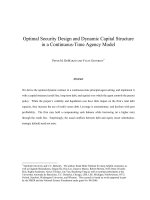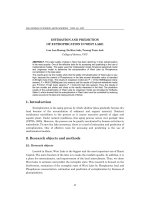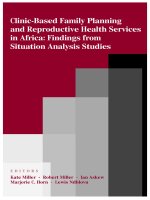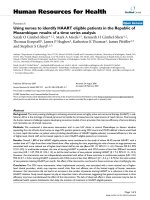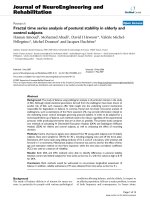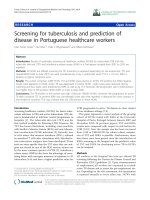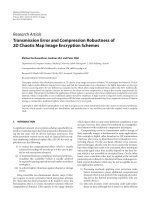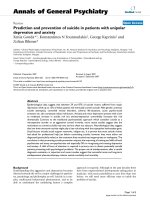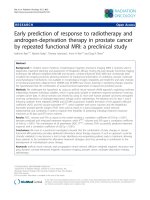Efficient and prediction enhancement schemes in chaotic hydrological time series analysis
Bạn đang xem bản rút gọn của tài liệu. Xem và tải ngay bản đầy đủ của tài liệu tại đây (4.56 MB, 254 trang )
EFFICIENT AND PREDICTION ENHANCEMENT
SCHEMES IN CHAOTIC HYDROLOGICAL TIME
SERIES ANALYSIS
DULAKSHI SANTHUSITHA KUMARI KARUNASINGHA
(B. Sc. Eng. (Hons), University of Peradeniya, Sri Lanka)
A THESIS SUBMITTED
FOR THE DEGREE OF DOCTOR OF PHILOSOPHY
DEPARTMENT OF CIVIL ENGINEERING
NATIONAL UNIVERSITY OF SINGAPORE
2005
ACKNOWLEDGEMENT
I would like to express my sincere and deep gratitude to my supervisor,
Associate Prof. Liong Shie-Yui, who guided my research work. His constructive
criticisms, valuable advices, suggestions and untiring guidance were very much helpful
to me in completing my thesis successfully. I must add that his advices and
encouragement were beyond the academic scope; they helped changing my attitudes
and improve my personal life. I highly appreciate his support and encouragement at
times when I was frustrated due to circumstances beyond our control. The freedom he
gave made my research work truly an enjoyable experience. I could not have made this
far without the help, encouragement and the freedom I received from him. I thank him
from the bottom of my heart.
I must express my sincere thanks and deep gratitude to Prof. K. S. Walgama,
who is behind all my academic endeavors since my graduation. He is the only one who
educated me not to miss the fun out of this PhD process; he also taught me how to
enjoy what I am doing. There was a time when it seemed that everything was going to
fall apart; he was the one who showed me that I was getting some life experience. And
taking his own experiences as examples he showed me how to face, appreciate and
learn from the problems. Without him, I would not have been doing a PhD.
I must express my sincere thanks to Dr. Janaka Wijekulasooriya, who helped
me with my leave matters, for placing trust in me and made my study in Singapore
possible. His encouragement and friendly advices are highly appreciated.
Thanks are extended to A/Prof. Lin Pengzhi as well.
I would like to express my sincere thanks to Associate Prof. S. Sathiya Keerthi
for his inspiring lectures on Neural Networks.
i
I would like to express my sincere thanks to Dr. Malitha Wijesundara for
helping me with the computer related matters throughout my PhD study.
I must thank Prof. N.E. Wijesundara for his guidance and encouragement in
tough times. I wish to thank Mr. OG Dayaratne Banda, Mr. Suranga Jayasena and Mr.
Lesly Ekanayake for listening to my worries when I was in despair, and for their
encouragement.
I wish to thank Dr. T. Vinayagam for helping me with the proofreading. I must
also thank my friend Ms. Dinuka Wijethunge for helping me with the proofreading (we
hadn’t exchanged a word for 14 years till I asked her favour this time -- still the same
friend whom I met in High School!) when she herself was busy with loads of work. I
must thank my friend Ms. Rochana Meegaskumbura too for her help on this boring
proofreading job.
I would also like to thank my friends and colleagues, Ms. Yu Xinying and Mr.
Doan Chi Dung (who are now Dr. Yu Xinying and Dr. Doan Chi Dung, of course!),
with whom I had a wonderful time, for their discussions on academic and non
academic matters. Xinying, the female PhD student! , perfectly understood me all the
time. I must thank my colleague Mr. M.F.K. Pasha for helping me in the initial stage
of my study.
Many thanks to Mr. Krishna of Hydraulics lab who is always there to lend his
assistance within his capacity. Thanks are also extended to the staff of Supercomputing
and Visualization Unit, NUS, for their help. Thanks to two final-year project students,
Andy and Afzal, for their help as well.
ii
As the names of those who helped me cascade down my memory I am feeling
happy and excited at the thought that there are so many helpful hands out there willing
to reach me in need. There are simply too many to mention their names. My sincere
thanks are extended to everyone who helped me in numerous ways.
My sincere thanks are extended to everyone at the Department of Engineering
Mathematics and the University of Peradeniya for granting me a study leave.
I would like to thank the National University of Singapore for granting me the
NUS research scholarship to pursue my Ph.D. study here.
Last, but not least, no words can express my deepest gratitude, love and
admiration to my parents, Mrs. P. G. Somawathie and Mr. K. G. Gunapala. They kept
all their sorrows secret so that their daughter is happy overseas with her study. Without
their words of encouragement and tolerance I would not have been able to complete
my study in Singapore. I must express my love and admiration for my sister, Lakshmi,
and my brother, Waruna, too, who kept all the problems to themselves to allow their
sister’s mind free from concerns during her study.
iii
TABLE OF CONTENTS
Page No.
ACKNOWLEDGEMENT
i
TABLE OF CONTENTS
iv
SUMMARY
xi
LIST OF TABLES
xiii
LIST OF FIGURES
xvii
LIST OF SYMBOLS
xx
CHAPTER 1
1
1.1
INTRODUCTION
CHAOTIC TIME SERIES ANALYSIS
2
1.1.1 Basics of Chaos
2
1.1.2 Chaos applications
3
PRESSING ISSUES
4
1.2.1 Local or global models?
4
1.2.2 Prediction with noisy data
5
1.2.3 Handling of large data sets
6
1.3
OBJECTIVES OF THE STUDY
7
1.4
ORGANIZATION OF THE THESIS
9
1.2
iv
CHAPTER 2
LITERATURE REVIEW
10
2.1
INTRODUCTION
10
2.2
BASICS OF CHAOS
10
2.3
ANALYSIS OF CHAOTIC TIME SERIES
12
2.3.1 System characterization
13
2.3.2 Determination of phase space parameters
15
2.3.2.1 Standard approach
15
2.3.2.2 Inverse approach
16
2.3.3 Prediction
18
2.3.3.1 Local Approximation: Averaging and
polynomial models
19
2.3.3.2 Global Approximation: Artificial Neural Network (ANN)
20
2.3.3.3 Global Approximation: Support Vector Machine (SVM)
21
2.3.4 Noise reduction
23
2.3.4.1 Introduction
23
2.3.4.2 Nonlinear Noise Reduction
25
2.3.4.3 Kalman filtering
26
2.4
PREDICTION OF CHAOTIC HYDROLOGICAL TIME SERIES
27
2.5
NOISE REDUCTION IN CHAOTIC HYDROLOGICAL TIME SERIES
32
2.6
LARGE DATA RECORD SIZE IN CHAOS APPLICATIONS
38
2.7
SUMMARY
41
v
CHAPTER 3 CHAOTIC TIME SERIES PREDICTION WITH
GLOBAL MODELS: ARTIFICIAL NEURAL
NETWORK AND SUPPORT VECTOR MACHINES
43
3.1
INTRODUCTION
43
3.2
DATA USED
44
3.2.1 Lorenz time series
44
3.2.2 Mississippi river flow time series
45
3.2.3 Wabash river flow time series
46
ANALYSIS: ARTIFICIAL NEURAL NETWORK AND LOCAL
MODELS
46
3.3.1 Methodology
46
3.3.2 Analysis on Noise-free chaotic Lorenz time series
48
3.3
3.3.2.1 Prediction with global Artificial Neural Network models
49
3.3.2.2 Results
51
3.3.3 Analysis on Noise added Lorenz time series
3.3.4 Analysis on river flow time series
57
SUPPORT VECTOR MACHINES AS A GLOBAL MODEL
58
3.4.1 Introduction
58
3.4.2 Support Vector Machine formulation with ε -insensitive
loss function
60
3.4.3 Decomposition algorithm for large scale SVM regression
63
3.4.4 Micro Genetic Algorithm for SVM parameter optimization
66
3.4.5 Implementation and Results
3.6
56
3.3.6. Conclusion
3.5
54
3.3.5. Discussion
3.4
52
68
COMPUTATIONAL TIME IN LOCAL/ GLOBAL PREDICTION
TECHNIQUES
70
CONCLUSION
72
vi
CHAPTER 4 REAL-TIME NOISE REDUCTION AND PREDICTION
OF CHAOTIC TIME SERIES WITH EXTENDED
KALMAN FILTERING
100
4.1
INTRODUCTION
100
4.2
IMPROVING PREDICTION PERFORMANCE OF
NOISY TIME SERIES
101
4.2.1 Introduction
101
4.2.2 Do models trained with less noisy data produce better predictions?
103
4.2.3 Do noise-reduced data inputs cause models to predict better?
105
EXTENDED KALMAN FILTER IN PREDICTION OF
NOISY CHAOTIC TIME SERIES
106
4.3.1 Extended Kalman Filter
107
4.3.2 Appropriateness of EKF in real-time noise reduction of
chaotic time series
114
4.3.3 Noisy data trained ANN model in EKF
116
4.3.4 Application of EKF with noisy data trained ANN: Lorenz
time series
119
SCHEME FOR REAL-TIME NOISE REDUCTION AND
PREDICTION
121
THE PROPOSED SCHEME WITH EKF NOISE-REDUCED
DATA: LORENZ SERIES
123
THE PROPOSED SCHEME WITH SIMPLE NONLINEAR
NOISE REDUCTION: LORENZ SERIES
125
4.6.1 Simple nonlinear noise reduction method
126
4.6.2 Application of simple nonlinear noise reduction on proposed
scheme
127
APPLICATION OF EKF AND THE NOISE-REDUCTION SCHEME
ON RIVER FLOW TIME SERIES
129
4.8
SUMMARY AND DISCUSSION OF RESULTS
130
4.9
CONCLUSION
132
4.3
4.4
4.5
4.6
4.7
vii
CHAPTER 5 DERIVING AN EFFECTIVE AND EFFICIENT DATA SET
FOR PHASE SPACE PREDICTION
146
5.1
INTRODUCTION
146
5.2
DATA EXTRACTION WITH SUBTRACTIVE
CLUSTERING METHOD
147
5.2.1 Subtractive clustering method
147
5.2.2 Procedure for data extraction
149
5.2.3 Results
151
SIMPLE CLUSTERING METHOD
153
5.3.1 Simple clustering algorithm
155
5.3.2 Application and results
156
5.3.3 Similarities/differences and advantages/disadvantages
of the simple clustering method over SCM
157
5.3.4 Simple clustering method applied on a multivariate
data set: Bangladesh data water level data
159
5.3.4
160
5.3
5.4
5.5
Tuning the parameter d
DATA EXTRACTION WITH SIMPLE CLUSTERING METHOD
DEMONSTRATED ON EKF NOISE REDUCTION APPLICATION
161
CONCLUSION
162
CHAPTER 6 CONCLUSIONS AND RECOMMENDATIONS
177
6.1
SUMMARY
177
6.2
GLOBAL MODELS IN CHAOTIC TIME SERIES PREDICTION
178
6.3
NOISE REDUCTION
179
6.4
DATA EXTRACTION
180
6.4
NEW SIMPLE CLUSTERING TECHNIQUE
181
6.5
RECOMMENDATIONS FOR FUTURE STUDY
182
viii
REFERENCES
184
APPENDIX A GRASSBERGER-PROCACCIA ALGORITHM FOR
CORRELATION DIMENSION CALCULATION
APPENDIX B
194
THE SUMMARY OF THE CHAOS ANALYSIS
PREDICTION SCHEME USED IN THE
196
APPENDIX C OPTIMAL PHASE SPACE PARAMETERS FOR
NOISE-FREE CHAOTIC LORENZ SERIES,
MISSISSIPPI AND WABASH RIVER FLOW
TIME SERIES
198
APPENDIX D PREDICTION PERFORMANCE OF VARIOUS
PREDICTION MODELS ON TEST SETS
APPENDIX E
APPENDIX F
200
PREDICTION PERFORMANCE OF FIRST AND
THIRD ORDER POLYNOMIAL MODELS
203
PERFORMANCE OF PREDICTION MODELS
TRAINED WITH DATA OF NOISE LEVELS
DIFFERENT FROM THAT OF VALIDATION
INPUT DATA
204
ˆ
APPENDIX G FINDING A POSTERIORI STATE ESTIMATE x k AS
A LINEAR COMBINATION OF AN A PRIORI
ˆ−
ESTIMATE x k AND NEW MEASUREMENT z k
208
APPENDIX H PREDICTION PERFORMANCE OF NOISE
REDUCTION APPLICATIONS ON NOISES
GENERATED FROM DIFFERENT SEEDS
211
ix
APPENDIX I
APPENDIX J
LORENZ SERIES IN THE APLICATION OF NOISE
REDUCTION
215
PERFORMANCE OF THE PROPOSED NOISE
REDUCTION SCHEME WITH SVM AS THE
PREDICTION TOOL
220
APPENDIX K NUMBER OF PATTERNS EXTRACTED AND THE
CORRESPONDING PREDICTION ERRORS WITH
DIFFERENT d VALUES
LIST OF PUBLICATIONS
222
229
x
SUMMARY
This study looked into means of improving prediction accuracy and facilitating
efficient analysis of chaotic hydrological time series. The objectives were: (1) to
investigate in detail the prediction performances of global prediction models (Artificial
Neural Network (ANN) and Support Vector Machine (SVM)) compared to some widely
used local prediction models (local averaging and local polynomial), and (2) to find
means of incorporating noise reduction techniques in prediction improvement schemes,
and (3) to investigate means of extracting system representative smaller sets of data from
long data records.
(1) Global models in chaotic time series prediction
A chaotic noise-free Lorenz time series, a Lorenz series contaminated with some
known noise levels, and two river flow time series were analyzed for 3 different
prediction horizons. ANN outperformed local prediction models practically in all the
cases. SVM, implemented with a decomposition technique to facilitate handling large
data records, also performed better than local models with the exception of noise-free
Lorenz series. On the average both global prediction techniques outperformed the local
prediction models considered; however, at the expense of longer computational time.
Comparison between performances obtained from ANN and from the relatively new
SVM showed that both are equally good. For real time series, the prediction
performance difference between them is insignificant.
(2) Noise reduction to improve predictions
Performance of both local and global models is unsatisfactory when data is noisy.
This study identified some means to improve the predictions of noisy chaotic time series.
It was shown that noise reduced inputs to a model can improve its prediction accuracy.
A general perception that the models trained with noise reduced data may help in
xi
improving prediction is found not necessarily true. The findings of this study show that
the prediction performance is not necessarily improved by such models if they are not
supported with inputs of equal or lesser noise levels. Hence, the study showed the
necessity of real-time application of noise reduction to improve prediction. Nonlinear
chaotic dynamics literature lacks established techniques capable of real-time noise
reduction. It was shown that the Extended Kaman filter, originated from Controls
literature, can be used as a reliable and robust technique for real-time noise reduction in
chaotic time series. The study proposed a better approach, which eliminated the shortcomings of the earlier approaches, to incorporate noise reduction to improve prediction
accuracy. The effectiveness of the proposed scheme was demonstrated with EKF.
(3) Data extraction
Large data record demands significant computational resources in chaos analysis.
This study proposed a procedure that couples a clustering method, a prediction method,
and an optimization method (mGA) to extract a smaller set of system representative data
from long data records. Demonstration with Subtractive Clustering Method, SCM (Chiu,
1994), on both synthetic and real time series, showed a considerable reduced data set
(approximately 30% - 60% of the total data set) can still achieve the same prediction
accuracy as that of the entire record. However, SCM, with four parameters to be
optimized, required significant computational effort.
New simple clustering technique
A new clustering method is developed in this study that has only one single parameter.
Method is shown to be as equally effective as SCM while it requires much less effort
than SCM. The new method, though developed for data extraction in chaotic time series,
was shown to be effective on some other multivariate data sets as well. Application of it,
on proposed noise reduction scheme with EKF, showed the potential in data extraction
procedure to yield efficient analysis of the normally time-consuming applications.
xii
LIST OF TABLES
Page
Table 3.1
Optimal phase space parameter sets with various models:
Noise-free Lorenz series
74
Table 3.2
Prediction errors with various models on validation set: Noisefree Lorenz series
74
Table 3.3
Optimal phase space parameter sets with various models: 5%
Noisy Lorenz time series
75
Table 3.4
Optimal phase space parameter sets with various models: 30%
Noisy Lorenz time series
75
Table 3.5
Prediction errors with various models on validation set: 5%
Noisy Lorenz series
76
Table 3.6
Prediction errors with various models on validation set: 30%
Noisy Lorenz series
76
Table 3.7
Optimal phase space parameter sets with various models:
Mississippi river flow
77
Table 3.8
The optimal phase space parameter sets with various models:
Wabash river flow
77
Table 3.9
Prediction errors with various models on validation set:
Mississippi river flow
78
Table 3.10
Prediction errors with various models on validation set:
Wabash river flow
78
Table 3.11
Optimal phase space parameter sets with SVM for different
time series
79
Table 3.12
Prediction errors with ANN and SVM on validation set: Noisefree Lorenz series
79
Table 3.13
Prediction errors with ANN and SVM on validation set: 5%
Noisy Lorenz series
80
Table 3.14
Prediction errors with ANN and SVM on validation set: 30%
Noisy Lorenz series
80
Table 3.15
Prediction errors with ANN and SVM on validation set:
Mississippi series
81
Table 3.16
Prediction errors with ANN and SVM on validation set:
Wabash series
81
xiii
Table 3.17
Approximate computational time for different prediction
methods with different time series
82
Table 4.1
Prediction performances of ANN models, trained with noisefree and noisy data sets, with noisy validation input data sets
134
Table 4.2
Prediction performance of ANN model trained with 30% noisy
data when noise-free, 1%, 10%, 20% and 30% noisy validation
data are used as inputs
134
Table 4.3
Summary of findings on means of improving prediction
performance
135
Table 4.4 (a)
Prediction performance of ANN models trained with noisy data
with equally noisy validation inputs: Lorenz time series
136
Table 4.4 (b)
Prediction performance of EKF predictor on Noise-induced
chaotic Lorenz time series
136
Table 4.5
Prediction performance of EKF estimates on the proposed
scheme: noise-induced chaotic Lorenz time series with ANN
137
Table 4.6
Prediction performance of nonlinear noise reduction on the
proposed scheme: noise-induced chaotic Lorenz time series
with ANN
137
Table 4.7
Prediction performance of ANN/ EKF predictor/ EKF estimates
and Nonlinear noise reduction on the proposed scheme: River
flow time series
138
Table 5.1
Criteria for selection of cluster centres
164
Table 5.2
Prediction errors of ANN and local averaging models trained
with the entire data set: Lorenz time series
165
Table 5.3
Prediction errors of ANN and local averaging models trained
with the entire data set: River flow time series
165
Table 5.4
Prediction errors of ANN trained using total training data
applied on validation set: Bangladesh water levels
166
Table 5.5
Prediction errors of EKF noise reduction application on 10%
noisy Lorenz series with total data in model training and
reduced data (with new clustering method) in model training
166
Table C.1
Optimal phase space parameter sets for Lorenz, Mississippi
river and Wabash river flow series
198
Table C.2
Prediction errors on validation set for different (m, τ): Wabash
River flow with lead time 1 prediction
Prediction errors with various models on test set:
Noise-free Lorenz series
198
Table D.1
200
xiv
Table D.2
Prediction errors with various models on test set: 5% Noisy
Lorenz series
200
Table D.3
Prediction errors with various models on test set: 30%
Noisy Lorenz series
201
Table D.4
Prediction errors with
Mississippi river flow
various
models
on
test
set:
201
Table D.5
Prediction errors
Wabash river flow
various
models
on
test
set:
201
Table D.6
Prediction errors of SVM on test sets: Noise-free, 5% noisy,
and 30% noisy Lorenz series
202
Table D.7
Prediction errors of SVM on test sets: Mississippi and Wabash
flow time series
202
Table E.7
Prediction errors with first, second and third order polynomial
models on validation set: Mississippi river flow
203
Table F.1
Prediction performance of ANN models trained with data of
known noise levels and validated on input data of the same
noise levels: Lorenz series
205
Table F.2
Prediction performance of ANN model trained with 1% noise
level data and validated with input data of other noise levels
205
Table F.3
Prediction performance of ANN model trained with 10% noise
level data and validated with input data of other noise levels
205
Table F.4
Prediction performance of ANN model trained with 20% noisy
data when 30% noisy validation data are used as inputs
206
Table F.5
Prediction performance of ANN model trained with 20% noise
level data and validated with input data of less noise levels
207
Table F.6
Prediction performance of ANN model trained with 10% noise
level data and validated with input data of less noise levels
207
Table F.7
Prediction performance of ANN model trained with 1% noise
level data and validated with input data of less noise levels
207
Table H.1
Prediction performance of ANN on noisy chaotic Lorenz time
series: with noises generated from different seeds
211
Table H.2
Prediction performance of EKF predictor on noisy chaotic
Lorenz time series: with noises generated from different seeds
212
with
xv
Table H.3
Prediction performance of EKF estimates on proposed
procedure: noisy chaotic Lorenz time series with ANN: with
noises generated from different seeds
213
Table H.4
Prediction performance of nonlinear noise reduction on the
proposed procedure: noisy chaotic Lorenz time series with
ANN: with noises generated from different seeds
214
Table I.1
Noise reduction – statistics
215
Table J.1
Prediction performance of EKF estimates on the proposed
procedure: noisy chaotic Lorenz series with SVM
221
Table J.2
Prediction performance of EKF estimates on proposed
procedure: river flow time series with SVM
221
Table K.1
d values and the corresponding number of patterns selected and
the prediction errors on validation set using for local model and
ANN: Noise free Lorenz series
222
Table K.2
d values and the corresponding number of patterns selected and
the prediction errors on validation set using for local model and
ANN: 5% noisy Lorenz series
223
Table K.3
d values and the corresponding number of patterns selected and
the prediction errors on validation set using for local model and
ANN: 30% noisy Lorenz series
225
Table K.4
d values and the corresponding number of patterns selected and
the prediction errors on validation set using for local model and
ANN: Mississippi river flow time series
226
Table K.5
d values and the corresponding number of patterns selected and
the prediction errors on validation set using for local model and
ANN: Wabash river flow time series
227
xvi
LIST OF FIGURES
Page
Figure 2.1
Kalman filter application (Maybeck and Peter, 1979)
42
Figure 2.2
Clustering: grouping objects into classes of similar objects
42
Figure 3.1
x(t) component of Lorenz time series
83
Figure 3.2
Mississippi river catchment
84
Figure 3.3
Mississippi river daily flow time series
85
Figure 3.4
Wabash river catchment
86
Figure 3.5
Wabash river daily flow time series
87
Figure 3.6
Architecture of Multi Layer Perceptron used in the study
88
Figure 3.7
Variation of prediction errors and computational times
with (a) number of hidden neurons and (b) number of
epochs: Lorenz series (m = 5, τ =1, T=3 prediction)
88
Figure 3.8
Schematic diagram of the selection procedure of optimally
trained MLP
89
Figure 3.9
Validation data and prediction errors in lead-time 5
predictions of various models: noise-free Lorenz series
90
Figure 3.10
Validation data and prediction errors in lead-time 5
predictions of various models: 5% Noisy Lorenz series
91
Figure 3.11
Validation data and prediction errors in lead-time 5
predictions of various models: 30% noisy Lorenz series
92
Figure 3.12
Correlation integral analysis and Fourier power spectrum
on Wabash river flow
93
Figure 3.13
Validation data and prediction errors in lead-time 5
predictions of various models: Mississippi flow series
94
Figure 3.14
Validation data and prediction errors in lead-time 5
predictions of various models: Wabash flow series
95
Figure 3.15
Schematic diagram of (m, t, c, std, eps) selection with
SVM
96
Figure 3.16
ε - insensitive loss function
97
xvii
Figure 3.17
Prediction with support vector machine
97
Figure 3.18
Schematic diagram of mGA
98
Figure 3.19
Implementation of SVM/ Matlab
99
Figure 4.1
Off-line and Real-time application of noise reduction
139
Figure 4.2
Performance evaluation of models derived of noisy and
noise-free data
140
Figure 4.3
Performance evaluation of model derived of 30% noisy
data with inputs of different quality
141
Figure 4.4
Discrete Kalman filter cycle
142
Figure 4.5
Tuning observation and process noise covariance in EKF
142
Figure 4.6
Prediction of validation data with EKF
143
Figure 4.7
Proposed scheme for real-time noise reduction and
prediction
143
Figure 4.8
Proposed scheme for real-time noise reduction and
prediction (in detail)
144
Figure 4.9
Mean square estimation error of Forward filtering/
Backward filtering and Smoothing
145
Figure 5.1
Overview of the data extraction procedure
167
Figure 5.2
Schematic diagram of calibration process of SCM
parameters
168
Figure 5.3
Schematic diagram of validation process of optimal
solutions
169
Figure 5.4
Performance of SCM on validation set: Noise-free Lorenz
series
170
Figure 5.5
Performance of SCM on validation set: 5% noisy Lorenz
series
170
Figure 5.6
Performance of SCM on validation set: 30% noisy Lorenz
series
170
Figure 5.7
Performance of SCM on validation set: Mississippi flow
time series
171
Figure 5.8
Performance of SCM on validation set: Wabash flow time
series
171
Figure 5.9
Trajectories of an attractor
172
xviii
Figure 5.10
Schematic diagram of the procedure followed with new
clustering method
172
Figure 5.11
Performance of Simple clustering method on validation
set: Noise-free Lorenz series
173
Figure 5.12
Performance of Simple clustering method on validation
set: 5% noisy Lorenz series
173
Figure 5.13
Performance of Simple clustering method on validation
set: 30% noisy Lorenz series
173
Figure 5.14
Performance of Simple clustering method on validation
set: Mississippi flow time series
174
Figure 5.15
Performance of Simple clustering method on validation
set: Wabash flow time series
174
Figure 5.16
Variation of number of patterns with neighborhood size
(d)
174
Figure 5.17
Schematic diagram of river system showing the stations
(ST)
175
Figure 5.18
Performance of Simple clustering method on validation
set: Bangladesh water levels with ANN model
175
Figure 5.19
The effective range for d : from d1 – d2
176
Figure 5.20
Comparison between prediction performance of smaller
data sets and total data set used to train model: EKF noise
reduction application
176
Figure B.1
Division of data sets in to training, test and validation sets
197
Figure I.1
10% noisy Lorenz series validation data (a) Noise free
data (b) noisy data and (c) EKF noise reduced data
216
Figure I.2
The Lorenz attractor for (a) noise-free, (b) 10% noisy data
and (c) EKF noise-reduced data with delay time of 1
217
Figure I.3
The Lorenz attractor for (a) noise-free, (b) 10% noisy data
and (c) EKF noise-reduced data with delay time of 6
218
Figure I.4
Prediction performance with and without noise reduction
219
xix
LIST OF SYMBOLS
Δt
=
Sampling interval
fT
=
Prediction function for T lead-time (actual)
ˆ
fT
=
Approximation of f T
FT
=
Global approximation function
FTi
=
Local approximation function
c(m, k )
=
Coefficients of polynomial models
φm ( X )
=
Polynomial basis functions
Z0
=
New point
Fk
=
Local polynomial function corresponding to point X k
k ( x, x ′)
=
Kernel function
xi
=
Input vector
yi
=
Output value
λk
=
Eigen value
φk ( x )
=
Nonlinear basis function of SVM
ϕ(x)
=
Feature space
W
=
Weights of SVM
Remp [ f ]
=
Training error
υn
=
Measurement noise
s( x )
=
Function that maps the points on the attractor into real numbers
wn
=
Dynamical noise
xx
′
νn
=
Remaining discrepancy of from dynamical equations, of a noise
reduced estimate
yi
=
Observed value of a time series (with noise)
&
x
=
First time derivative of variable x of Lorenz system
&
y
=
First time derivative of variable y of Lorenz system
&
z
=
First time derivative of variable z of Lorenz system
ˆ
xi
=
Predicted value of xi
x
=
Average value of the time series
ε
=
ε -insensitive distance parameter
ξ (*)
=
Slack variables in SVM optimization problem
α (*)
=
Lagrange multipliers in SVM optimization problem
η (*)
=
Lagrange multipliers in SVM optimization problem
e k−
=
A priori error estimate
ek
=
A posteriori error estimate
Pk−
=
A priori estimate error covariance
Pk
=
A posteriori estimate error covariance
ˆ
x k−
=
A priori state estimate
ˆ
xk
=
A posteriori state estimate
Pk
=
A posteriori estimate error covariance
ε
=
Neighbourhood size of simple nonlinear noise reduction method
σ
=
Standard deviation of noise (in nonlinear noise reduction)
ra
=
Influence range
xxi
P1*
=
Highest potential
rb
=
Range in which the points will have considerable reduction in
potential
k′
=
Modified nearest neighbours value
d
=
Parameter of the new clustering method
Ak
=
Matrix relating the previous state to the current state
ANN
=
Artificial Neural Network
AR
=
Accept ratio
b
=
Scalar constant of SVM
Bk
=
Matrix relating the control input, u to the state x
C
=
Constant determining the trade off between the complexity and
training error
EKF
=
Extended Kalman Filter
Hk
=
Matrix relating state x to measurement z
k
=
Number of nearest neighbours
Kk
=
Kalman gain
m
=
Embedding dimension
M
=
Number of basis functions
MAE
=
Mean absolute error
mGA
=
Micro Genetic Algorithm
MLP
=
Multilayer perceptron
NB
=
Number of nearest neighbours
NRMSE
=
Normalized root mean square error
Pi
=
Potential of a data point (in clustering)
Q
=
Process noise covariance
R
=
Observation noise covariance
B
xxii
RR
=
Reject ratio
SCM
=
Subtractive Clustering Method
SF
=
Squash factor (in clustering)
SVM
=
Support Vector Machine
T
=
Lead time/ Prediction horizon
u
=
Control input
UKF
=
Unscented Kalman filter
w
=
weight
Xi
=
Phase space vector
xi
=
Value of a time series
z
=
Measurement of a system
σ
=
Width parameter of the Gaussian kernel
τ
=
Time delay
xxiii
CHAPTER 1
INTRODUCTION
Prediction of hydrological and meteorological time series is an important task in
understanding the hydrological and meteorological systems. In the past, linear
stochastic approaches such as ARMA were widely used in the prediction of
hydrological time series. However, the inherent assumptions underlying such
approaches such as linearity may not be applicable to complex and nonlinear
hydrological systems (Jayawardena and Gurung, 2000). With the recent developments
in chaos theory, it was revealed that most real world systems may be better understood
using chaotic dynamical systems theory (e.g. Lorenz, 1963; Jayawardena and Lai,
1994; Rodriguez-Iturbe et al, 1989). This is a relatively new and developing field and
yet it has shown promise in identification and prediction of nonlinear real world
systems. Particularly due to its potential shown in short term prediction the approach is
now gaining popularity in many diverse fields (e.g. physics, chemistry, biology,
meteorology, etc) including the prediction of nonlinear hydrological time series.
Prediction of time series with this chaotic dynamical systems approach is
generally referred to as phase space prediction. The development of phase space
prediction models requires a large number of past records. Most of the current research
focuses on methods to further improve the performance of phase space prediction.
However, only the traditional local phase space prediction models, which have limited
capacity, are widely used owing to their simplicity and ease in implementation with
large number of data records. The presence of noise in data also considerably
deteriorates the performance of phase space prediction (Kantz and Schreiber, 2004).
Searching for and investigating more sophisticated prediction models and noise
1
